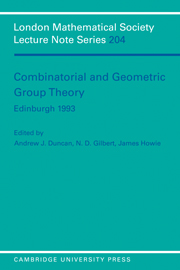Book contents
- Frontmatter
- Contents
- Foreword
- Participants
- On bounded languages and the geometry of nilpotent groups
- Finitely presented groups and the finite generation of exterior powers
- Semigroup presentations and minimal ideals
- Generalised trees and Λ-trees
- The mathematician who had little wisdom: a story and some mathematics
- Palindromic automorphisms of free groups
- A Freiheitssatz for certain one-relator amalgamated products
- Isoperimetric functions of groups and exotic cohomology
- Some embedding theorems and undecidability questions for groups
- Some results on bounded cohomology
- On perfect subgroups of one-relator groups
- Weight tests and hyperbolic groups
- A non-residually finite, relatively finitely presented group in the variety N2A
- Hierarchical decompositions, generalized Tate cohomology, and groups of type (FP)∞
- Tree-lattices and lattices in Lie groups
- Generalisations of Fibonacci numbers, groups and manifolds
- Knotted surfaces in the 4-sphere with no minimal Seifert manifolds
- The higher geometric invariants of modules over Noetherian group rings
- On calculation of width in free groups
- Hilbert modular groups and isoperimetric inequalities
- On systems of equations in free groups
- Cogrowth and essentiality in groups and algebras
- Regular geodesic languages for 2-step nilpotent groups
- Finding indivisible Nielsen paths for a train track map
- More on Burnside's problem
- Problem Session
Semigroup presentations and minimal ideals
Published online by Cambridge University Press: 05 April 2013
- Frontmatter
- Contents
- Foreword
- Participants
- On bounded languages and the geometry of nilpotent groups
- Finitely presented groups and the finite generation of exterior powers
- Semigroup presentations and minimal ideals
- Generalised trees and Λ-trees
- The mathematician who had little wisdom: a story and some mathematics
- Palindromic automorphisms of free groups
- A Freiheitssatz for certain one-relator amalgamated products
- Isoperimetric functions of groups and exotic cohomology
- Some embedding theorems and undecidability questions for groups
- Some results on bounded cohomology
- On perfect subgroups of one-relator groups
- Weight tests and hyperbolic groups
- A non-residually finite, relatively finitely presented group in the variety N2A
- Hierarchical decompositions, generalized Tate cohomology, and groups of type (FP)∞
- Tree-lattices and lattices in Lie groups
- Generalisations of Fibonacci numbers, groups and manifolds
- Knotted surfaces in the 4-sphere with no minimal Seifert manifolds
- The higher geometric invariants of modules over Noetherian group rings
- On calculation of width in free groups
- Hilbert modular groups and isoperimetric inequalities
- On systems of equations in free groups
- Cogrowth and essentiality in groups and algebras
- Regular geodesic languages for 2-step nilpotent groups
- Finding indivisible Nielsen paths for a train track map
- More on Burnside's problem
- Problem Session
Summary
Introduction
The purpose of this paper is first to give a survey of some recent results concerning semigroup presentations, and then to prove a new result which enables us to describe the structure of semigroups defined by certain presentations.
The main theme is to relate the semigroup S defined by a presentation II to the group G defined by II. After mentioning a result of Adjan's giving a sufficient condition for S to embed in G, we consider some cases where S maps surjectively (but not necessarily injectively) onto G. In these examples, we find that S has minimal left and right ideals, and it turns out that this is a sufficient condition for S to map onto G. In this case, the kernel of S (i.e. the unique minimal two-sided ideal of S) is a disjoint union of pairwise isomorphic groups, and we describe a necessary and sufficient condition for these groups to be isomorphic to G.
We then move on and expand on these results by proving a new result (Theorem 9), which is a sort of rewriting theorem, enabling us to determine the presentations of the groups in the kernel in certain cases. We finish off by applying this new result to certain semigroup presentations and by pointing out its limitations.
- Type
- Chapter
- Information
- Combinatorial and Geometric Group Theory, Edinburgh 1993 , pp. 29 - 42Publisher: Cambridge University PressPrint publication year: 1994



